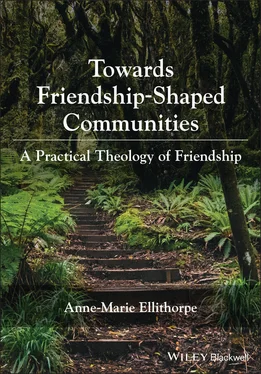Christian friendship is often viewed as simply sociological, “a matter of people who like one another and enjoy associating with one another at church and at various church-related functions.” 45 Without an intentionally cultivated theological imagination, cultural norms take precedence within the social imagination of Christians. Yet despite being undervalued in Christian theology, friendship is embedded in the Christian social imaginary.
Throughout the twentieth and into the twenty-first century, the friend has been identified or portrayed in a variety of ways by Christian authors, theologians and otherwise, including as a model of the neighbor, a model for Christian love, a cornflower in the wheat field, a support in the struggle against evil, and as unnecessary yet invaluable. Whereas some Christians identified friendship as an ethical relationship, or as having ethical value, others discounted its ethical significance. For some, the recognition of friendship’s importance was solidified through the experience of war.
In J.R.R. Tolkien’s The Lord of the Rings , written during the inter-war period and profoundly shaped by his experience of the First World War, friendship-love is portrayed as integral to the overcoming of evil. Within this implicitly theological saga, set in a pre-Christian and non-religious world, friendships develop through commitment to a shared quest, within small communities seeking to resist evil. 46 Tolkien portrays friendship as being characterized by love, loyalty, respect, and trust. Strider admits to the hobbits that he hoped they would take to him for his own sake: “A hunted man sometimes wearies of distrust and longs for friendship.” 47 The wizard Gandalf recognizes that friendship, rather than simply tenacity, will be needed by the younger hobbits Merry and Pippin, as they are selected to go on a dangerous journey. 48 Through the relationships among his various characters, Tolkien identifies the pain and loss that accompanies authentic friendship, particularly when friendship sustains service in the pursuit of a greater good. 49 Ancient conventions of distrust between races are challenged by the friendship between Legolas the Grey-Elf and Gimli the Dwarf and between the hobbit Merry Brandybuck and the human King Théoden.
In the same inter-war period, European theologians grappled with the relationship of friendship to the love of neighbor to which God’s people are called in both testaments. 50 Reformed German theologian Karl Barth identified the friend as a model of the neighbor, asserting that the concept of friendship is neither more nor less than “the root of” the concept of neighbor. 51 Friendship provides a corrective to a potentially egotistical life, Barth argued. Mature relationships with family members may have the character of friendship; likewise, the marriage relationship has the potential to acquire this character. 52 Similarly, while Swiss theologian Emil Brunner viewed friendship as a form of culture, springing from natural spiritual impulses and belonging to the recreational realm, he recognized potential for friendship to become a bridge to the “ethical realm” and to foreshadow community. 53
Other Europeans, however, discounted friendship as being of ethical significance. During the early decades of the twentieth century, much was made of the nuances between the various biblical and Hellenistic Greek words for love. The differences were at times overstated, as is apparent in Swedish Lutheran scholar Anders Nygren’s influential Agape and Eros . This work proposes a sharp distinction between two kinds of human love: self-giving altruistic love descending from God (without attachment or the need for reciprocation) and self-loving desiring love seeking to climb to God. 54 Nygren had little use for philia , the love of friends, which he regarded as essentially selfish in nature and being based in part on desire for the other. 55 It is worth keeping in mind that Nygren’s fundamental concern in this work is the source of human fellowship with God, rather than relationships between humans. Nevertheless, while his personal practice, as teacher and bishop, may have been substantially different, his writing effectively dismissed philia as a subsidiary of eros , a love that seeks reward. While Nygren’s anti-Hellenistic theory is now widely recognized as extreme and as inconsistent with linguistic evidence within the Greek Bible, his polemic has nevertheless been highly influential. His perception of Christian love as unconditional altruism was widely accepted. Nygren’s work has been described as “the most influential Protestant account of love in the twentieth century.” 56 Friendship became a disdained term among seminarians, or at least among certain types of seminarians. 57 The ideas of Agape and Eros ruled in many classrooms and pulpits. 58
Nevertheless, in 1938, Anglican priest and Cambridge scholar John Burnaby became the first academic since Thomas Aquinas to argue on a scholarly level for friendship as the quintessential model for Christian love. In Amor Dei , Burnaby challenges Nygren’s anti-mystical tendency and champions the love for God that energized the Christian mystical tradition. Burnaby found the delight, desire, and devotion inherent to friendship with God to be immeasurably greater, both like and very unlike that shared with a human friend. 59
Subsequently, a variety of reflections on friendship emerged from the Second World War years. Simone Weil, a French philosophical writer, mystic, and activist in the wartime Resistance, asserted that whereas natural affection tends to be based on a relationship of necessity, pure friendship surpasses nature. For Weil, friendship was a miracle, with a sacramental character. 60 In a letter written from prison shortly before his execution by the Nazis in 1945, Dietrich Bonhoeffer wondered about friendship as a subdivision of the concept of culture. 61 Noting the challenge of classifying friendship sociologically, 62 Bonhoeffer questioned the restrictiveness of Reformed domains of ethical existence, namely family, state, and work, 63 and the Protestant sidelining of the whole sphere of freedom, including friendship, art, education, and play. 64 As Liz Carmichael notes, “it is in the experience of such struggles as that in which Bonhoeffer was caught up in that the ethical significance of friendship makes itself starkly evident.” 65 Bonhoeffer depicted friendship as a rare and precious treasure, not to be compared with the values of the divine mandates (church, marriage and family, government, culture, and work), yet “as much in place amongst them as the cornflower in the wheat field.” 66 Friendship was thus portrayed as self-sown, unique, and fragile. It is not deliberately planted, nor does it belong to or receive support from the main crop.
C.S. Lewis wrote broadly and explicitly on friendship. In The Four Loves , Lewis sought to establish, from his nuanced understandings of love, implications for contemporary living. Yet Lewis tended to overdraw the distinction between the terms agapē , eros , philia , and storge . Reality is more complex than his four categories of love allow. Friendship is depicted as invaluable, yet unnecessary. Lewis considered the cultivation of true friendships to be almost a lost art and expressed disappointment at the neglect of friendship within modern society. 67 Lewis favored friendship love as being the most closely aligned to divine love, because he viewed it as the most spiritual and least physical of the loves, an affair of “disentangled, or stripped minds.” 68 Yet within this work he made minimal use of the tradition of ethical or theological writing on friendship, but rather wrote a somewhat personal essay, reflecting the kind of companionship he himself enjoyed. While Lewis does not explicitly target Nygren’s Agape and Eros in The Four Loves , this work implicitly criticizes Nygren’s denigration of eros as having no part in agapē . 69 Lewis’s portrayal of these four loves in the novel Till We Have Faces is perhaps even more critical of Nygren. 70
Читать дальше












